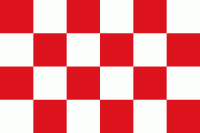North Brabant (Noord-Brabant ; Brabantian: Broabant; ), also unofficially called Brabant, is a province in the south of the Netherlands. It borders the provinces of South Holland and Gelderland to the north, Limburg to the east, Zeeland to the west, and the Flemish provinces of Antwerp and Limburg to the south. The northern border follows the Meuse westward to its mouth in the Hollands Diep strait, part of the Rhine–Meuse–Scheldt delta. North Brabant has a population of 2,562,566 as of November 2019. Major cities in North Brabant are Eindhoven (pop. 231,642 ), Tilburg (pop. 217,259), Breda (pop. 183,873) and its provincial capital 's-Hertogenbosch (pop. 154,205).
The Duchy of Brabant was a state of the Holy Roman Empire established in 1183 or 1190. It developed from the Landgraviate of Brabant and formed the heart of the historic Low Countries, part of the Burgundian Netherlands from 1430 and of the Habsburg Netherlands from 1482, until it was split up after the Dutch revolt. After the War of Independence, Catholics in the Southern Netherlands were systematically and officially discriminated against by the Northern Protestant government until the second half of the 19th century, which had a major influence on the economic and cultural development of the southern part of the Netherlands.
Present-day North Brabant (Staats-Brabant) was adjudicated to the Generality Lands of the Dutch Republic according to the 1648 Peace of Westphalia, while the reduced duchy remained in existence with the Southern Netherlands until it was conquered by French Revolutionary forces in 1794.
Until the 17th century, the area that now makes up the province of North Brabant was mostly part of the Duchy of Brabant, of which the southern part is now in Belgium. During the 14th and 15th centuries, the area experienced a golden age—especially the now-Belgian cities of Brussels, Mechelen, Leuven and Antwerp, and the Dutch cities of Breda, Bergen op Zoom and 's-Hertogenbosch.
After the Union of Utrecht was signed in 1579, Brabant became a battlefield between the Protestant Dutch Republic and Catholic Spain, which occupied the southern Netherlands. As a result of the Peace of Westphalia, the northern part of Brabant became part of the Netherlands as the territory of Staats-Brabant (Statal Brabant) under federal rule, in contrast to the founding provinces of the Dutch Republic, which were self-governing.
Attempts to introduce Protestantism into the region were largely unsuccessful; North Brabant remained strongly Catholic. For over a century, North Brabant served mainly as a military buffer zone. In 1796, when the confederate Dutch Republic became the unitary Batavian Republic, Staats-Brabant became a province as Bataafs Brabant. This status ended with the reorganisation by the invading French, and the area was united into the département of Deux-Nčthes (present province of Antwerp).
In 1815, Belgium and the Netherlands were united in the United Kingdom of the Netherlands, and the province of North Brabant was established and so named to distinguish it from South Brabant in present-day Belgium, which seceded from the Kingdom in 1830. This boundary between the Netherlands and Belgium is special in that it does not form a contiguous line, but leaves a handful of tiny enclaves (and enclaves inside enclaves) on both sides of the border. In fact, the Dutch government generally used the pre-Napoleonic borders in 1815 to divide its provinces, in hommage to the principle of Restoration. A few of these irregularities were corrected (Luyksgestel was exchanged for Lommel), Huijbergen became totally Dutch, but some remain, notably Baarle-Hertog (Belgian) and Baarle-Nassau (Dutch).
When the present province was instituted, its territory was expanded with a part of the province of Holland and the former territory of Ravenstein, which had previously belonged to the Duchy of Cleves, as well as several small, formerly autonomous entities.
In World War II the area was liberated by the allies during Operation Pheasant between October 20 to November 4, 1944.
The period from 1900 until the late 1960s is called Het Rijke Roomse Leven (translated as 'the rich Roman life', with 'Roman' meaning 'Roman Catholic'), an era of strong religious belief. Het Rijke Roomse Leven came about as result of the emancipatory drive of the province's disadvantaged Catholic population and was supported by a Roman Catholic pillar, which was directed by the clergy, and not only encompassed churches, but also Roman Catholic schools and hospitals, which were run by nuns and friars. In those days every village in North Brabant had a convent from which the nuns operated. Politically, the province was dominated by Catholic parties: the Roman Catholic State Party and its post-war successor, the Catholic People's Party, which often held around 75% of the vote.























































